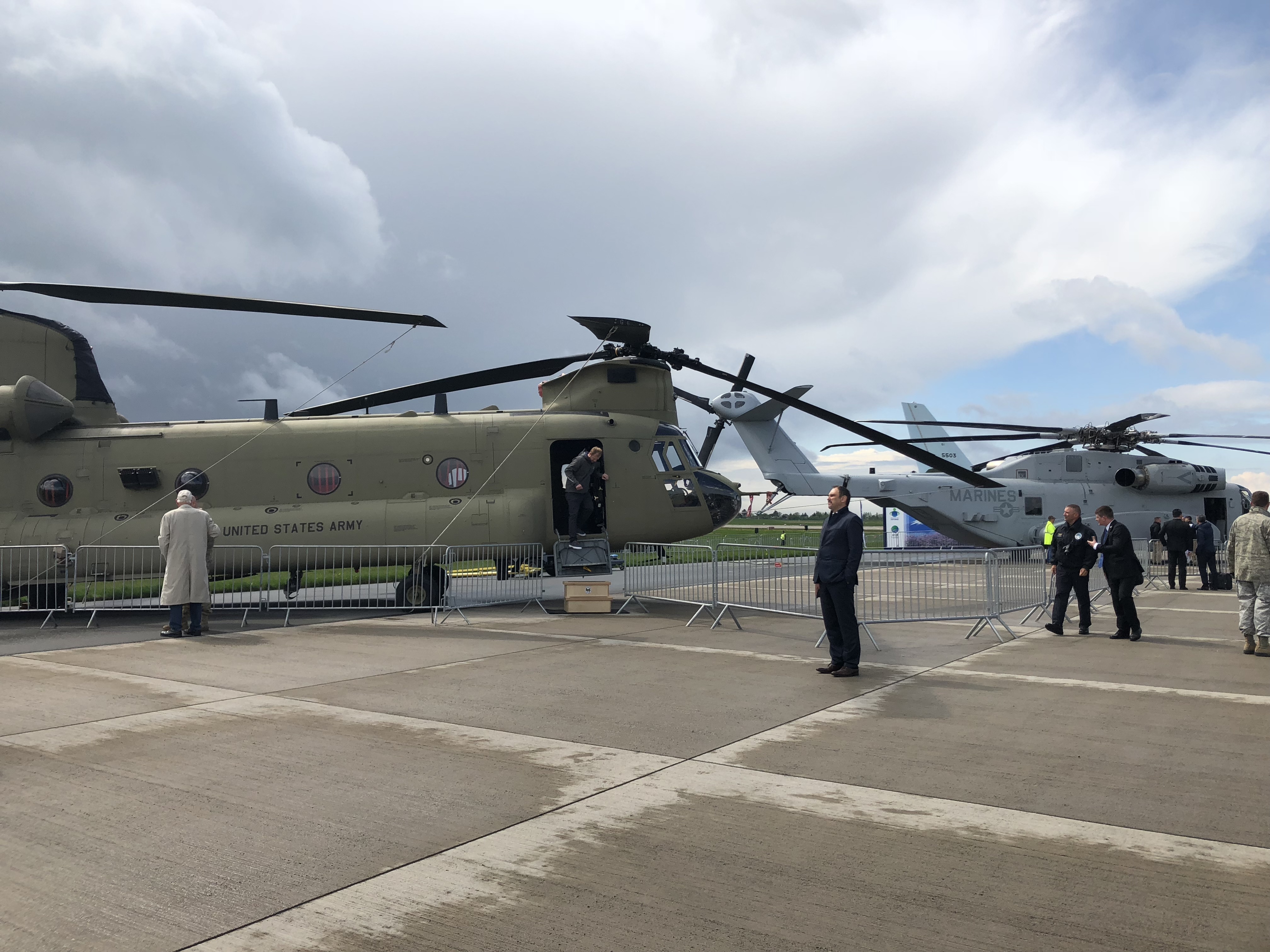Lockheed Martin's
new CH-53K helicopter takes to the skies over Berlin
Israel is eyeing the costly, next generation heavy-lift
helicopter to replace its ageing Yasur fleet.
By Anna Ahronheim
April 30, 2018 13:58
Jerusalem Post Hi tech news
Lockheed Martin
Sikorsky's Ch-53K on the tarmac at Berlin Air Show. (photo credit: ANNA
AHRONHEIM)
A front-runner to become Israel’s new heavy-lift
helicopter, the CH-53K King Stallion, took to the skies last week making its
international flying debut at the Berlin Air Show where it demonstrated its
flight capabilities, maneuverability and advanced fly-by-wire technology.
Built by Lockheed Martin Sikorsky, the same maker of the Yasur – which has been
in use by the Israel Air Force since 1969 – the CH-53K is competing against
Boeing Co.’s smaller twin-rotor CH-47 Chinook helicopter for Israel’s business
– a competition that pits an expensive next-generation aircraft against a
less-expensive global workhorse.
With a maximum carrying weight of 36,000 pounds, the
CH-53K offers three times the carrying power of its predecessor and has been
designed by the company to ensure reliability, low maintenance and enhanced
survivability.
“I can tell you with confidence that this is not your average helicopter,”
Sikorsky president Dan Schultz told reporters, explaining that while the body
of the aircraft may look similar to the Yasur, the CH-53K is a “modern
aircraft” with digital fly-by-wire avionics, fully integrated flight and
navigation displays, composite airframe, aluminum gearboxes and triple
redundant systems.
“It’s going to be a safer system,” said Col. Hank Vanderborght, a manager of
the CH-53K program for the US Marine Corps, which is buying 200 of the
helicopters, four of which are to be declared ready for combat use by December
2019.
With a cruising speed of 360 kph (223 miles/hr) and a range of 530 miles, the
aircraft can be used in a variety of missions, including rescue operations,
transport missions, tactical troop lifts as well as support for special
operations.
“For us in the Marine Corps, we have almost the same size helicopter that is
replacing the 53E but this helicopter [CH-53K] can lift three times more in the
same ambient conditions and that is a significant step in capabilities,”
Vanderborght said.
Another main advantage of the aircraft is its aerial refueling capability,
which can significantly increase the range of the aircraft, he said. When asked
by reporters if that meant opening the possibility to fly to Iran and back, he
responded: “Correct, wherever you want to go.”

The CH-53K on it's
maiden flight in the skies of Berlin (ANNA AHRONHEIM)
“At the end of the day, during war, if you can’t get the
stuff and the people to where it needs to be at the right time at the right
place, you are not as effective in the battle-space as you could be,” said
Vanderborght.
Echoing Vanderborght, CH-53K pilot Lt.-Col. J.C. Morel told The Jerusalem
Post that the workload for pilots in the helicopter is “significantly
reduced” due to the fly-by-wire avionics.
According to Morel, one of the more challenging aspects for pilots is not being
able to see, such as during low-level flying or in demanding conditions such as
in the desert.
“If you look at the No. 1 cause of air crashes it’s usually due to human
error,” he said. “With this aircraft almost everything has been offloaded to
computers, which are able to fly the aircraft. When it comes down to the
critical aspect of landing in the middle of the desert at night in this
aircraft, you just press a button and it lands itself.”
“Pilots have more time to focus on the mission, to communicate and make
decisions,” he added, reducing the possibility of pilot error.
According to Schultz, big data analytics is another key feature of the
aircraft, which by having a predictive maintenance diagnostic system is able to
reduce costs for the customer by identifying issues and notifying maintenance
crews when a part needs to be replaced.
Schultz said that by not outsourcing the building of its transmissions and
rotor blades, the planes and helicopters “are the most reliable and dependable
out there,” also boosting the readiness rates of the aircraft over 90%.

Boeing's Chinook
Helicopter alongside the CH-53K (ANNA AHRONHEIM)
With Israel needing to replace their 50-year-old Yasur
heavy-lift aircraft by 2025, Col. Vanderborght said that the timeline to
deliver the CH-53K to Israel – should the aircraft be chosen – is expected to
be around 2023-2024.
One main issue for the Israeli Air Force about the CH-53K is the high cost, as
it averages a unit purchase price of $87 million, which, even with
non-recurring costs, can even increase across the helicopter’s life cycle. This
is more than double the cost of the Chinook, which costs $38.5m. per aircraft.
But, according to Schultz, with Germany interested in buying 45 to 60 of the
CH-53K, the procurement cost for Israel could be reduced.
The Chinook is an advanced and versatile multi-role and multi-mission
helicopter that features a full digital management system in the cockpit. In
service in 20 different countries, it is a twin-engine, tandem rotor heavy-lift
helicopter used mainly for troop transport, artillery placement and battlefield
resupply. It has a cruising speed of 291 kph and mission range of 370.4 km.
Boeing’s Chinook was also on display at the Berlin Air Show and according to
Steve Barlage, the senior manager for global sales – vertical lift division,
the Chinook is “the right answer” for Israeli military requirements.
“It is a modern aircraft with proven reliability, low cost and affordability
when buying the aircraft and the life-cycle costs are significantly lower when
compared to other aircraft in its class,” he said.
According to Barlage, Boeing is currently producing three to four aircraft per
month and if chosen by Israel, the IAF can have the Chinook operational within
months.
“They can place the order and have the aircraft operational and ready to go at
a moment’s notice,” he said.


